Hot-Hot-Hot
31/08/13 09:20
Hot-Hot-Hot here in Grenada.
Generally a breeze makes it so much more comfortable, but the last few days we’ve had much lighter winds. Add in a few moquitos in the evening and I haven’t been able to get any sleep the past few nights...
I do have a couple of fans that blow air around in the fwd cabin, but these calm night there isn’t the outside breeze blowing in the hatch. Its just the same old air getting stale and warm throughout the night! Yuck!
The problem is that the cool night air is staying outside - we need that air in the cabin. So yesterday I hung up this Caframo Fan designed for just this purpose.
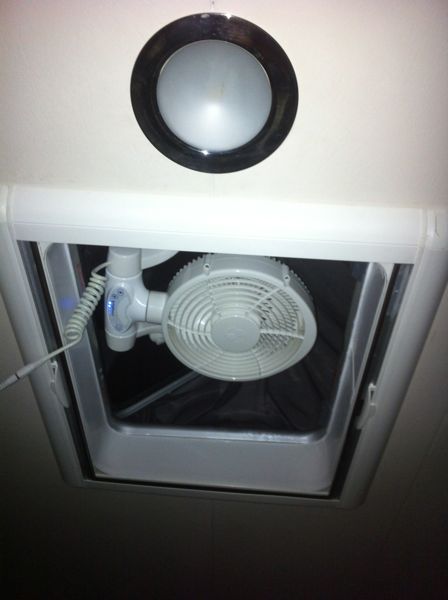
It attaches to the hatch with suction cups and plugs into a 12Volt socket.
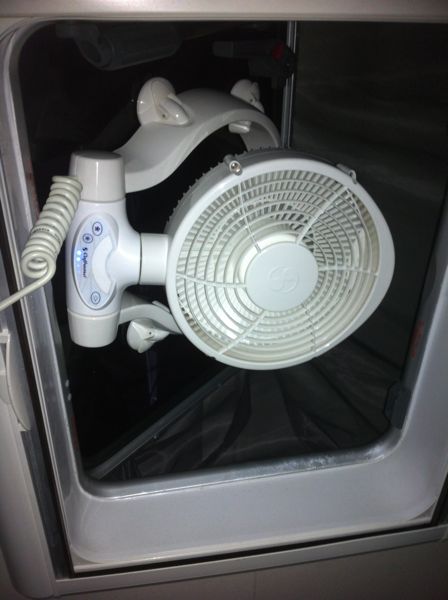
Talk about a world of difference. With this fan on the cabin becomes cool breezy and comfortable!! The grill on the bottom there appears to be designed to spread the air around and it works great. Best nights sleep I have had in the marina!
Installing the fan was as simple as sticking on the suction cups, but I should still have read the manual first. As I was sweltering and the fan looked like a simple device I just jumped right in and started pressing buttons... suddenly the fan spun up like an Airbus 320 on takeoff - and produced a gale in the cabin of similar proportions. If I had been reading the manual it would have been blown out of my hands :-)
In the calm light of next morning I read the manual to find that this is feature! Press the small fan button and it accellerates to "Air Blast Exchange Mode" for 5 minutes before reverting to the previous set mode. RTFM - read the frickin manual Paul!!

Note the large fan button adjusts the speed - the smaller button activates TURBO mode. There is even a Cabin light built in.
Current use is minimal - less than 1 amp which is difficult to measure on my monitor so I will quote from the manual again.
Speed 1 - 0.2 amps
Speed 2 - 0.5 amps
Speed 3 - 0.95 amps
AirBlast - 4.3 amps (but just for 5 minutes)
The fan also turns to act as an exhaust if desired.
Hot nights!! Bring them on!!
Generally a breeze makes it so much more comfortable, but the last few days we’ve had much lighter winds. Add in a few moquitos in the evening and I haven’t been able to get any sleep the past few nights...
I do have a couple of fans that blow air around in the fwd cabin, but these calm night there isn’t the outside breeze blowing in the hatch. Its just the same old air getting stale and warm throughout the night! Yuck!
The problem is that the cool night air is staying outside - we need that air in the cabin. So yesterday I hung up this Caframo Fan designed for just this purpose.

It attaches to the hatch with suction cups and plugs into a 12Volt socket.

Talk about a world of difference. With this fan on the cabin becomes cool breezy and comfortable!! The grill on the bottom there appears to be designed to spread the air around and it works great. Best nights sleep I have had in the marina!
Installing the fan was as simple as sticking on the suction cups, but I should still have read the manual first. As I was sweltering and the fan looked like a simple device I just jumped right in and started pressing buttons... suddenly the fan spun up like an Airbus 320 on takeoff - and produced a gale in the cabin of similar proportions. If I had been reading the manual it would have been blown out of my hands :-)
In the calm light of next morning I read the manual to find that this is feature! Press the small fan button and it accellerates to "Air Blast Exchange Mode" for 5 minutes before reverting to the previous set mode. RTFM - read the frickin manual Paul!!

Note the large fan button adjusts the speed - the smaller button activates TURBO mode. There is even a Cabin light built in.
Current use is minimal - less than 1 amp which is difficult to measure on my monitor so I will quote from the manual again.
Speed 1 - 0.2 amps
Speed 2 - 0.5 amps
Speed 3 - 0.95 amps
AirBlast - 4.3 amps (but just for 5 minutes)
The fan also turns to act as an exhaust if desired.
Hot nights!! Bring them on!!
Comments
Bilge Alarm!!
27/04/13 06:46
Are you sinking??
Every once in a while you hear a story like this...
A sailor on watch pops down to get a cup of tea and finds the floorboards awash.
Or...
Waking up in his bunk the sailor puts his foot out to find he is ankle deep in water...
Or...
A couple out on deck at night enjoying a romping sail start to feel the boat is a bit sluggish... they find the boat has taken on so much water they can’t trace the leak since everything is awash... the boat sinks and they abandon ship...
All of these stories are true but in most cases I believe they could have been prevented.
One of the most common causes of sinking is simply some sort of leak that went undetected until it was too late. A hose clamp fails, a hose bursts, a pump back-syphons, an anti-syphon valve sticks, a thruhull fitting cracks... you get the idea. Modern boats are somewhat complicated and many things COULD go wrong.
The main point is that many of these potential leaks is small and easy to deal with IF you know you have a problem. Unfortunately most boats do not let you know you have that problem! A beautiful little Rule Automatic bilge pump will deal with a certain amount of water coming in to the bilge. It will continue to try to keep up with the leak but it is so quiet that you will likely not hear it and never know you have a problem.
A bilge alarm can solve this! And for a VERY affordable price it is the cheapest insurance you can buy!!
Bilge Alarm Options
Broadly speaking there are two types of bilge alarm. Water detectors and bilge-pump alarms. One will detect water that is getting to a dangerous level. The second detects when you bilge pump has activated itself.
Water detector
Bilge alarms can be a simple water detector. It sounds an alarm if water is detected in the bilge. Then you have to decide how to install it. You could set this detector above the level of the automatic pump. This means basically to set a water detector so that it will sound when it gets up above the bilge pump. So in effect you wait until the bilge pump is overwhelmed and then sound an alarm. For very wet boats this might be the right solution but it does sound a bit scary...
Alternatively it can be set up to detect ANY water in the bilge by putting it below the level the bilge pump will activate. Then you will hear the alarm whenever water enters the bilge. It depends on the type of boat you have whether you might prefer this. Our first boat "Two-Step" had a very deep bilge and all water would drain to this small space where the bilge pumps were located. Pour 1 litre of water into the bilge anywhere and it would drain down to this bucket-sized bilge where it would set off this alarm.
Bilge Pump Alarm
Another option is to connect a loud alarm to let you know the bilge pump has been activated. This is my preferred solution and I have installed these alarms on all our boats. It is really quite simple and inexpensive - the ones I installed on Distant Shores II cost less than $4 each. What a DEAL for such super insurance!!
Here is how its done...
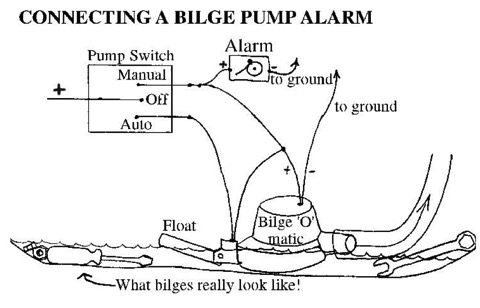
Basically all you have to do is connect a beeper or buzzer to the manual side of the typical bilge pump control. This means any time the pump has power then the alarm will sound.
Optional - I also added a switch to turn the alarm off again. In the event the bilge pump DOES come on and you are busy trying to find the leak, you might want to turn off the alarm. I installed the switch inline with the alarm. Easy and made the price more than $5 total!!
Every once in a while you hear a story like this...
A sailor on watch pops down to get a cup of tea and finds the floorboards awash.
Or...
Waking up in his bunk the sailor puts his foot out to find he is ankle deep in water...
Or...
A couple out on deck at night enjoying a romping sail start to feel the boat is a bit sluggish... they find the boat has taken on so much water they can’t trace the leak since everything is awash... the boat sinks and they abandon ship...
All of these stories are true but in most cases I believe they could have been prevented.
One of the most common causes of sinking is simply some sort of leak that went undetected until it was too late. A hose clamp fails, a hose bursts, a pump back-syphons, an anti-syphon valve sticks, a thruhull fitting cracks... you get the idea. Modern boats are somewhat complicated and many things COULD go wrong.
The main point is that many of these potential leaks is small and easy to deal with IF you know you have a problem. Unfortunately most boats do not let you know you have that problem! A beautiful little Rule Automatic bilge pump will deal with a certain amount of water coming in to the bilge. It will continue to try to keep up with the leak but it is so quiet that you will likely not hear it and never know you have a problem.
A bilge alarm can solve this! And for a VERY affordable price it is the cheapest insurance you can buy!!
Bilge Alarm Options
Broadly speaking there are two types of bilge alarm. Water detectors and bilge-pump alarms. One will detect water that is getting to a dangerous level. The second detects when you bilge pump has activated itself.
Water detector
Bilge alarms can be a simple water detector. It sounds an alarm if water is detected in the bilge. Then you have to decide how to install it. You could set this detector above the level of the automatic pump. This means basically to set a water detector so that it will sound when it gets up above the bilge pump. So in effect you wait until the bilge pump is overwhelmed and then sound an alarm. For very wet boats this might be the right solution but it does sound a bit scary...
Alternatively it can be set up to detect ANY water in the bilge by putting it below the level the bilge pump will activate. Then you will hear the alarm whenever water enters the bilge. It depends on the type of boat you have whether you might prefer this. Our first boat "Two-Step" had a very deep bilge and all water would drain to this small space where the bilge pumps were located. Pour 1 litre of water into the bilge anywhere and it would drain down to this bucket-sized bilge where it would set off this alarm.
Bilge Pump Alarm
Another option is to connect a loud alarm to let you know the bilge pump has been activated. This is my preferred solution and I have installed these alarms on all our boats. It is really quite simple and inexpensive - the ones I installed on Distant Shores II cost less than $4 each. What a DEAL for such super insurance!!
Here is how its done...

Basically all you have to do is connect a beeper or buzzer to the manual side of the typical bilge pump control. This means any time the pump has power then the alarm will sound.
Optional - I also added a switch to turn the alarm off again. In the event the bilge pump DOES come on and you are busy trying to find the leak, you might want to turn off the alarm. I installed the switch inline with the alarm. Easy and made the price more than $5 total!!
Sailing South - Keeping Cool
06/09/12 02:24
Now that we have got to the south of France we are having the hottest weather we have experienced on this boat to date. So we are making sure Distant Shores II will be keeping cool for the tropical sailing ahead.
Air Conditioning?
Before you make a big investment in air-conditioning it pays to make the boat as cool as possible with simpler methods. Check out all the possible easy and environmentally friendly options... before going to AC.
It’s curtains for you now...
Our saloon has big lovely windows for great views in exotic locations, but when the sun is shining in directly it does get hot. Keeping the sun out is the first thing to do. But traditional curtains don’t work on boats. We have added these nifty boat blinds that have slide easily up and down on guide lines so they don’t sway around at sea. This one is over our forward windows - probably the biggest heat absorber as they are nearly horizontal.
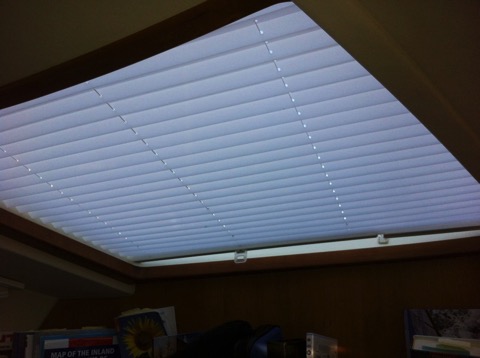
These are made by Breeze-blinds in the UK. You can see they have to be custom made since most boat windows are odd shapes. These are cunningly made so they conform to the non-square space. They can be left partially up as well (see below)
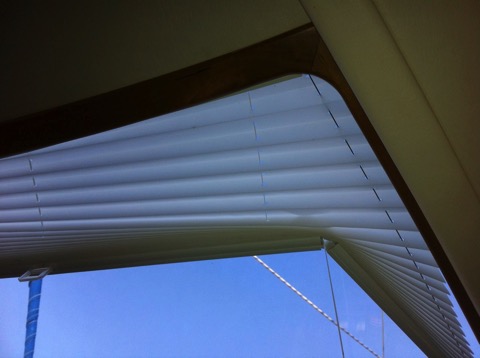
Fans
Now that we have reduced the sun coming in on a hot day we tackled the heat with some quality marine fans.
These units use VERY little power and are a great way to move air and keep cool. I have installed this lovely Caframo Fan in the galley.
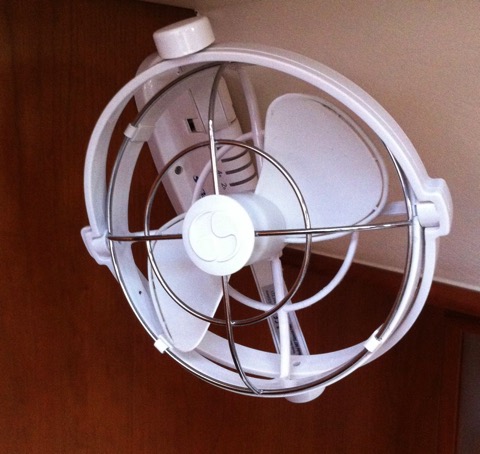
It turns and tilts so you can aim it anywhere. It has 3 speeds and even a timer so it can turn off automatically after a number of hours. But I think its best feature is its very clever folding and directional ability. It can tun any which way to get air into the galley or across into the saloon. Beautifully built and nice and quiet too!
Fans for all Sleeping Cabins
On a hot night it’s luxury to turn on the fan and feel that cool air! I installed two fans over our main double berth and one in each guest cabin. One over each bedside lamp. These are Caframo 3 speed units. Very sturdy and quiet. They also adjust to almost any angle.
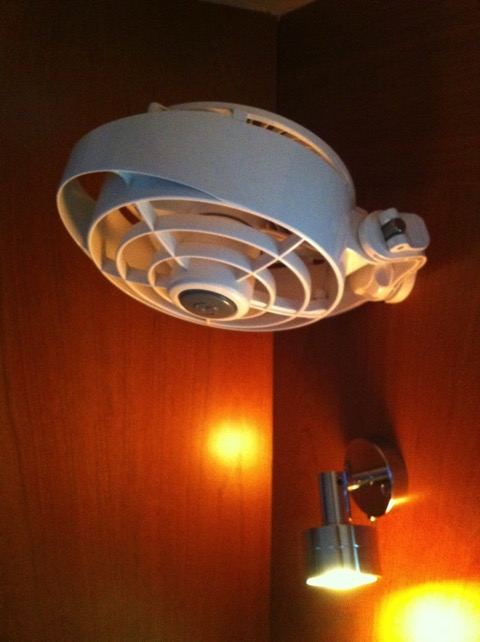
Economical to Run
Even if we have all 5 fans up and running at full speed we are using very little power. It would be a infinitesimal amount compared to running an Air-Con unit. So at anchor or in a marina where you can pay quite a lot for power - fans and curtains are the best option for us!
Air Conditioning?
Before you make a big investment in air-conditioning it pays to make the boat as cool as possible with simpler methods. Check out all the possible easy and environmentally friendly options... before going to AC.
It’s curtains for you now...
Our saloon has big lovely windows for great views in exotic locations, but when the sun is shining in directly it does get hot. Keeping the sun out is the first thing to do. But traditional curtains don’t work on boats. We have added these nifty boat blinds that have slide easily up and down on guide lines so they don’t sway around at sea. This one is over our forward windows - probably the biggest heat absorber as they are nearly horizontal.

These are made by Breeze-blinds in the UK. You can see they have to be custom made since most boat windows are odd shapes. These are cunningly made so they conform to the non-square space. They can be left partially up as well (see below)

Fans
Now that we have reduced the sun coming in on a hot day we tackled the heat with some quality marine fans.
These units use VERY little power and are a great way to move air and keep cool. I have installed this lovely Caframo Fan in the galley.

It turns and tilts so you can aim it anywhere. It has 3 speeds and even a timer so it can turn off automatically after a number of hours. But I think its best feature is its very clever folding and directional ability. It can tun any which way to get air into the galley or across into the saloon. Beautifully built and nice and quiet too!
Fans for all Sleeping Cabins
On a hot night it’s luxury to turn on the fan and feel that cool air! I installed two fans over our main double berth and one in each guest cabin. One over each bedside lamp. These are Caframo 3 speed units. Very sturdy and quiet. They also adjust to almost any angle.

Economical to Run
Even if we have all 5 fans up and running at full speed we are using very little power. It would be a infinitesimal amount compared to running an Air-Con unit. So at anchor or in a marina where you can pay quite a lot for power - fans and curtains are the best option for us!
Solar Power Onboard?
03/02/12 06:48
Looking forward to the next cruising season I am investigating whether we could add solar power to Distant Shores.
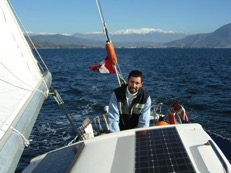 We had two 55-watt panels on Two-Step and it was excellent to see power coming in from the sun as we hung at anchor. The two panels were mounted on the spray dodger and in full sun could put out 6-7 amps. Of course I had to swing the boom out to one side since any shade cut out put dramatically. I think on a nice sunny day we might have got 30-35 amps total. This is much less than you might hope but we couldn’t aim the panels and shade did come on them often as the boat swung on the hook.
We had two 55-watt panels on Two-Step and it was excellent to see power coming in from the sun as we hung at anchor. The two panels were mounted on the spray dodger and in full sun could put out 6-7 amps. Of course I had to swing the boom out to one side since any shade cut out put dramatically. I think on a nice sunny day we might have got 30-35 amps total. This is much less than you might hope but we couldn’t aim the panels and shade did come on them often as the boat swung on the hook.
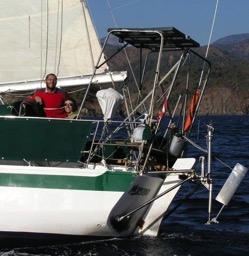 To obtain higher efficiency a number of boats have solar panels mounted on some construction at the stern such as our friends on Narena sailing here off the south coast of Turkey. I have started playing with some sketches to see if we could build some sort of stern arch for Distant Shores II but so far haven’t got anything to work yet.
To obtain higher efficiency a number of boats have solar panels mounted on some construction at the stern such as our friends on Narena sailing here off the south coast of Turkey. I have started playing with some sketches to see if we could build some sort of stern arch for Distant Shores II but so far haven’t got anything to work yet.
Solar Power - How Much do you need?
The modern boat has got more electrical appliances on than the cruising sailboat of 20 years ago. We all have our i-devices, computers, watermaker, navigation system etc. Some have air-con, washer/dryer vacuum cleaner etc. So although we have big electrical savings in things like LED lighting, the boat overall uses much more than before. So how much can solar power do? Could you ever really run the whole boat from solar power?
With Two-Step’s 2 X 55 Watt panels we just extended the time between running the engine to charge up the battery. We would have needed perhaps 3 times as many panels to keep up with all demands - and that assumed a sunny tropical day.
So the first thing to do is re-examine that electrical budget and make sure it is accurate. Is there anything to be gained (such as changing over any lighting that isn’t LED or fluorescent)?
On Distant Shores our electrical consumption worked out at over 200 amp-hours per day. Distant Shores II is similar but with 2 main differences. We have the same fridge/freezer unit with keel-cooler but also have an additional freezer unit. We also have the excellent Imtra LED lighting throughout. So while we have saved quite a bit in power through the lighting, we have used a fair bit extra with the additional freezer. And our experience with DSII has been sailing in cool northern summers. So when we get to warm tropical waters the freezer will use more than it does now. Just how much we don’t know... but we might be looking at over 250 amp hours per day. That’s a lot to get from solar panels!
I will do more on this in the next little while and post more.
How about you? Are you looking at Solar power? Do you have a working solar installation that is providing what your boat needs? Please give me your comments either by email or over on our Facebook page.
Is Sheryl pondering a new solar panel arch?
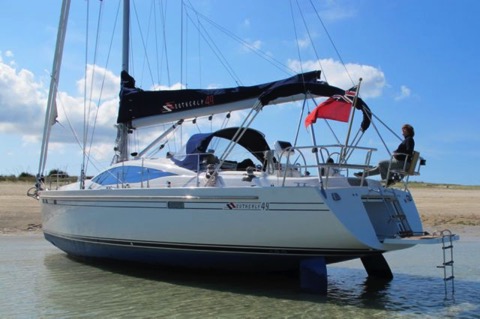


Solar Power - How Much do you need?
The modern boat has got more electrical appliances on than the cruising sailboat of 20 years ago. We all have our i-devices, computers, watermaker, navigation system etc. Some have air-con, washer/dryer vacuum cleaner etc. So although we have big electrical savings in things like LED lighting, the boat overall uses much more than before. So how much can solar power do? Could you ever really run the whole boat from solar power?
With Two-Step’s 2 X 55 Watt panels we just extended the time between running the engine to charge up the battery. We would have needed perhaps 3 times as many panels to keep up with all demands - and that assumed a sunny tropical day.
So the first thing to do is re-examine that electrical budget and make sure it is accurate. Is there anything to be gained (such as changing over any lighting that isn’t LED or fluorescent)?
On Distant Shores our electrical consumption worked out at over 200 amp-hours per day. Distant Shores II is similar but with 2 main differences. We have the same fridge/freezer unit with keel-cooler but also have an additional freezer unit. We also have the excellent Imtra LED lighting throughout. So while we have saved quite a bit in power through the lighting, we have used a fair bit extra with the additional freezer. And our experience with DSII has been sailing in cool northern summers. So when we get to warm tropical waters the freezer will use more than it does now. Just how much we don’t know... but we might be looking at over 250 amp hours per day. That’s a lot to get from solar panels!
I will do more on this in the next little while and post more.
How about you? Are you looking at Solar power? Do you have a working solar installation that is providing what your boat needs? Please give me your comments either by email or over on our Facebook page.
Is Sheryl pondering a new solar panel arch?

Weighing in on the MOVE!
28/05/07 13:53
Two-Step has been sold here in Malta! We are very happy about this since Malta is one of our favourite places – now we will have an excuse to come back and visit. The buyers are planning to sail her here and around Greece, an probably further afield in the future. Sheryl and I will be doing one more short cruise on her over the next two weeks – then packing up our gear and shipping it up to the UK, where we pick up the new boat in September!!
SO this weeks blog is on STUFF ON A BOAT THAT HAS ACCUMULATED OVER 18 YEARS!!!!
I started this project by trying to work out how much weight we might be adding to the new boat as we put gear on her. I was trying to figure how much impact all our stuff would have on the waterline and trim of the new boat. Although I am keen on many of the new gadgets and comforts available to sailors, I do believe there is a limit to how much equipment you can safely add before the boats handling is impaired. So my project started off by noting the weights for everything we were proposing to add to the new boat. This project is ongoing as we add and subtract gear from the plan. I will post a list with weights in a few weeks.
Meanwhile I realized that the general accumulated gear that were planning to move from Two-Step to the new boat would weight substantially more than all the toys I had been worrying about. So I have created a spreadsheet and am in the middle of systematically weighing the contents of every locker, itemising the contents and putting them in a spreadsheet. Rather than list each item I sometimes group a few and list the bunch and where they are such as “Port Bookshelf : cookbooks – 4.4Kilograms” (10 pounds). At this point the list has almost 300 entries, total weight is 571Kg and I am just 2/3 of the way done!!
The fun part of putting it on the computer is that I can find such interesting trivia as...
I guess the key here is that our boat is just 37 feet long and we do try to keep an eye on total weight on board – but still we will likely have more than 800Kg (almost 1800 pounds) which is heavier than a Smart Car (Smart Fortwo weighs 730Kg). So the next time you are thinking of stocking up on cheap beer just to save a few dollars – consider that 4 cases of 24 cans would add almost 40Kg. And you can forget taking up rock collecting!!
I am also working on a weight distribution plan for the new boat. Over the years we have repainted the waterline on Two-Step to cover her overweightness. I am hoping the new boat will not suffer the same fate! See you next time...
SO this weeks blog is on STUFF ON A BOAT THAT HAS ACCUMULATED OVER 18 YEARS!!!!
I started this project by trying to work out how much weight we might be adding to the new boat as we put gear on her. I was trying to figure how much impact all our stuff would have on the waterline and trim of the new boat. Although I am keen on many of the new gadgets and comforts available to sailors, I do believe there is a limit to how much equipment you can safely add before the boats handling is impaired. So my project started off by noting the weights for everything we were proposing to add to the new boat. This project is ongoing as we add and subtract gear from the plan. I will post a list with weights in a few weeks.
Meanwhile I realized that the general accumulated gear that were planning to move from Two-Step to the new boat would weight substantially more than all the toys I had been worrying about. So I have created a spreadsheet and am in the middle of systematically weighing the contents of every locker, itemising the contents and putting them in a spreadsheet. Rather than list each item I sometimes group a few and list the bunch and where they are such as “Port Bookshelf : cookbooks – 4.4Kilograms” (10 pounds). At this point the list has almost 300 entries, total weight is 571Kg and I am just 2/3 of the way done!!
The fun part of putting it on the computer is that I can find such interesting trivia as...
- All gear stored in or forward sleeping cabin weighs 135Kg and in the Saloon (not including Galley and Quarterberth) weighs 213Kg.
- Together all three cockpit lockers contain 200Kg of gear.
- Books weigh a startling 69Kg and that doesn't yet include the paperbacks we keep in the Quarterberth
- The category of “food” has a number of entries totalling 59Kg and we are quite low on provisions at the moment. Wine alone weighs 21Kg and we usually have at least 2-3 times as much. (Hey – we're in the Med!)
- All the ropes stored in lockers total 28Kg and doesn't include any running rigging – mainly dock lines and a spare 60 meter anchor rode - 10Kg.
- I have everything in a category such as food, electronics, books, clothes, and NGATI (Never Got Around To It) Items I bought but haven't installed. This is actually at it's lowest in years but we still carry 5Kg of stuff I never installed!
- Clothing totals 69Kg and in the interests of political correctness I an not going to reveal whether “pink or blue” clothes are heavier ;-)
I guess the key here is that our boat is just 37 feet long and we do try to keep an eye on total weight on board – but still we will likely have more than 800Kg (almost 1800 pounds) which is heavier than a Smart Car (Smart Fortwo weighs 730Kg). So the next time you are thinking of stocking up on cheap beer just to save a few dollars – consider that 4 cases of 24 cans would add almost 40Kg. And you can forget taking up rock collecting!!
I am also working on a weight distribution plan for the new boat. Over the years we have repainted the waterline on Two-Step to cover her overweightness. I am hoping the new boat will not suffer the same fate! See you next time...